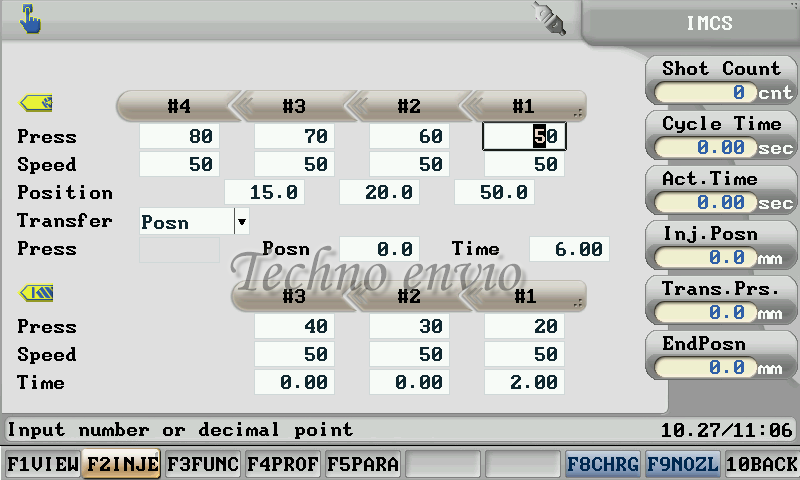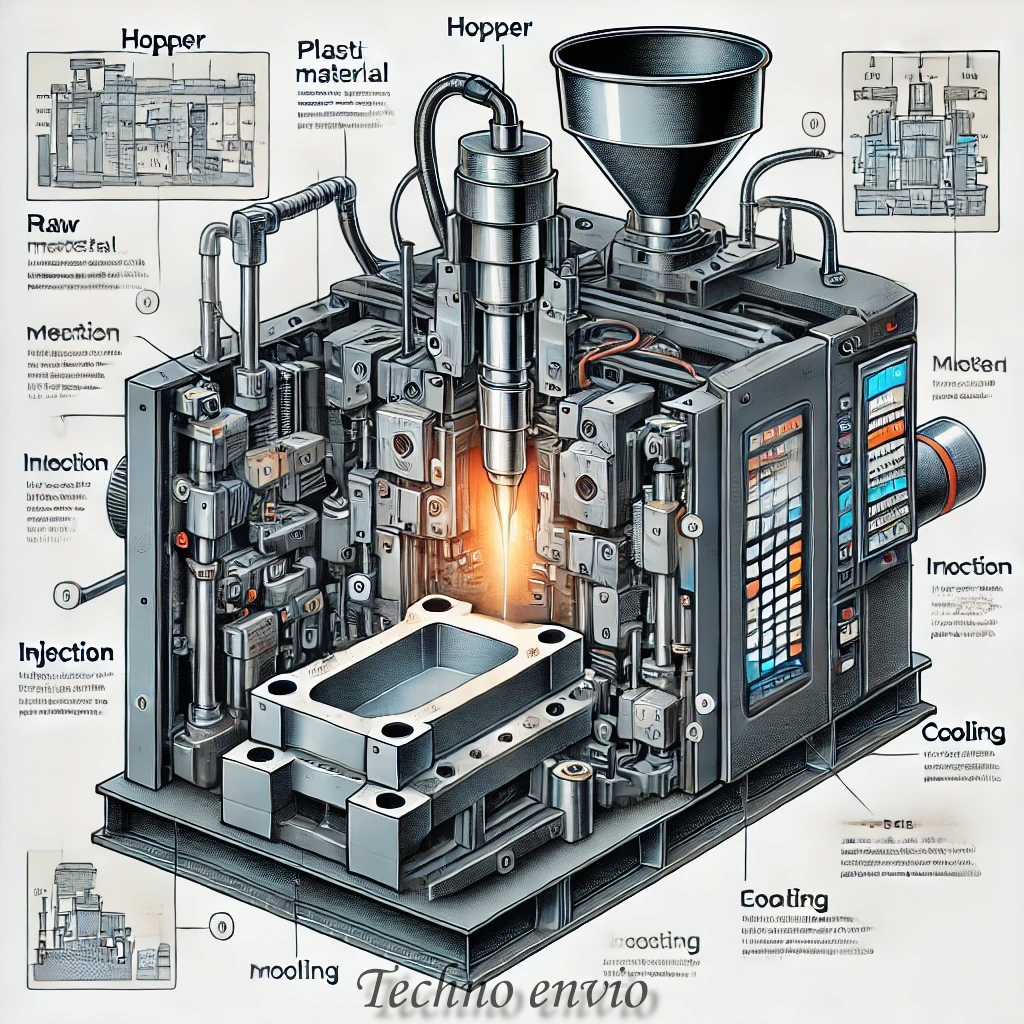Table of Contents
ToggleMastering the Operation of Injection Molding Machines: A Beginner’s Guide
Injection molding machines are vital in producing a variety of plastic products. Mastering their operation can lead to increased efficiency, cost savings, and high-quality results. Below is a detailed guide on mastering every aspect of injection molding machine operation.
Understanding the Basics of Injection Molding Machines

Explanation:
Injection molding is the process of forcing molten plastic into a mold, where it cools and solidifies into the desired shape. This chapter covers the essential components of the machine:
- Hopper: Where raw plastic material (in pellet form) is stored and fed into the machine.
- Barrel and Screw: The screw rotates inside the barrel, heating and moving the plastic toward the mold.
- Mold: The tool that shapes the plastic into the final product. It’s divided into two halves: a core and a cavity.
Understanding these parts helps beginners get familiar with the machinery before diving deeper.
Types of Injection Molding Machines
Explanation:
There are three main types of injection molding machines:
- Hydraulic machines: Powered by hydraulic pumps, they offer high power and are commonly used in heavy-duty applications.
- Electric machines: Operated by electric motors, they are energy-efficient, precise, and quieter, often used in smaller applications.
- Hybrid machines: A combination of both hydraulic and electric, offering a balance of power and precision.
This chapter helps beginners understand which type of machine fits different production needs.
The Role of Material Selection
Explanation:
The type of plastic resin used in injection molding affects product quality and machine settings. This section explains popular plastic materials like Polypropylene (PP), Polyethylene (PE), and Polycarbonate (PC). Each material has a unique melting point, viscosity, and flow characteristics, so the machine settings need to be adjusted accordingly for optimal performance.
Injection Molding Machines Setup for Beginners

Explanation:
Setting up the machine involves several critical steps:
- Material loading: Ensuring the right plastic resin is loaded into the hopper.
- Mold installation: Properly securing the mold in the machine to avoid defects.
- Parameter adjustments: Inputting the correct temperature, pressure, and injection speed settings based on the material being used.
This chapter guides you through the basic setup process to prevent errors.
Safety First: Operating Guidelines

Explanation:
Injection molding machines are complex and potentially dangerous if mishandled. Safety practices include:
- Wearing protective gear like gloves, goggles, and ear protection.
- Understanding the emergency stop buttons and other safety features.
- Regular safety checks of the machine, including hydraulic lines and electrical systems.
This chapter highlights essential safety measures to protect operators and ensure smooth operation.
Temperature Control in Injection Molding Machines

Explanation:
Temperature affects how plastic flows into the mold. If it’s too hot, the plastic may degrade; if too cold, it won’t flow properly. This section explains how to:
- Set and monitor the barrel temperature for melting plastic.
- Adjust the mold temperature to ensure proper cooling and solidification.
Mastering temperature control prevents defects like burn marks or short shots (incomplete fills).
Injection Speed and Pressure: Key Settings

Explanation:
Injection speed determines how fast the plastic enters the mold, while injection pressure affects how forcefully it’s pushed in.
- Fast injection speeds can lead to defects like flash (plastic flowing outside the mold).
- High pressure can cause mold damage.
This chapter explains how to fine-tune these settings based on the part’s complexity, mold design, and material type.
Mastering Cycle Times for Efficient Production

Explanation:
Cycle time refers to the entire process, from when the machine closes the mold to when the part is ejected. Reducing cycle time improves productivity. This chapter provides tips on optimizing each phase (injection, cooling, ejection) without sacrificing product quality.
For example, adjusting cooling times properly can help avoid warped parts while keeping production running fast.
Clamping Force: Why It Matters

Explanation:
Clamping force is the pressure that keeps the mold closed during the injection process. Too much force can damage the mold, while too little can cause flash or incomplete filling.
This section explains how to calculate the correct clamping force based on the size of the mold and material viscosity, ensuring a clean, precise molding process.
Cooling and Ejection: The Final Steps

Explanation:
After the plastic is injected, it needs time to cool before it can be ejected from the mold. Cooling too quickly or unevenly can cause warping, while improper ejection can damage the part or the mold.
This section
covers the importance of optimizing the cooling process and using the right ejection techniques, such as using ejector pins, to safely remove the part without causing defects.
Troubleshooting Common Operational Issues
Explanation:
Even with a well-maintained machine, issues may arise. Some common problems include:
- Short shots: The mold isn’t filled completely due to low injection pressure or temperature.
- Flash: Excess plastic leaks out of the mold because of low clamping force or high injection pressure.
- Warping: Uneven cooling leads to a distorted product.
This chapter offers troubleshooting steps for identifying and solving these problems to minimize production downtime.
The Importance of Maintenance in Machine Operation
Explanation:
Regular maintenance extends the machine’s lifespan and improves product consistency. Key tasks include:
- Cleaning molds to prevent material buildup.
- Checking hydraulic systems for leaks or pressure issues.
- Monitoring the screw and barrel for wear and tear.
A well-maintained machine reduces costly repairs and ensures smooth, reliable operation.
Understanding Mold Design and Its Impact on Operation
Explanation:
Mold design plays a crucial role in determining how the molten plastic flows, cools, and solidifies. Factors like gate location, venting, and runner system design affect the quality of the molded product.
This section explains how a well-designed mold improves efficiency and reduces defects, providing insights into how mold design can be optimized for different products.
Monitoring Machine Performance
Explanation:
Regularly tracking performance metrics helps detect problems early and improves productivity. Key indicators include:
- Cycle time: Shorter times improve efficiency but can’t sacrifice product quality.
- Scrap rate: Monitoring defects helps pinpoint issues in material, mold, or machine settings.
- Energy consumption: High energy usage could indicate inefficient machine settings.
This chapter teaches you how to monitor these metrics for optimal machine performance.
Calibration: Keeping Your Machine Accurate
Explanation:
Calibration ensures that the machine operates within its intended parameters. Regular calibration checks are vital for maintaining accuracy in settings like injection pressure, temperature, and clamping force.
This section provides a step-by-step guide to calibrating an injection molding machine, ensuring consistency in production quality.
Avoiding Machine Overload
Explanation:
Overloading the machine, either by running it too fast or pushing it beyond its capacity, can cause damage and lead to expensive downtime. Common signs of overload include overheating, excess vibration, and unusual noises.
This chapter explains how to recognize signs of overload and adjust the machine settings to prevent long-term damage.
Adjusting for Different Materials
Explanation:
Different materials have unique properties, such as melting points, viscosity, and shrinkage rates. This chapter teaches how to adjust machine parameters like temperature, pressure, and injection speed based on the type of plastic resin being used, whether it’s ABS, Polypropylene, or Nylon.
Energy Efficiency in Injection Molding Machines
Explanation:
Injection molding machines, especially older models, can be energy-intensive. Newer machines often have energy-saving features, such as variable-speed drives or heat recovery systems. This section explains how to maximize these features to reduce energy consumption and operating costs, which is increasingly important for manufacturers looking to lower their environmental footprint.
Advanced Techniques: Automation in Injection Molding Machines
Explanation:
Automation, like robotic arms and sensors, can streamline production by improving precision, reducing labor costs, and minimizing human error. This chapter explores how automation can be integrated into the injection molding process to handle tasks like part removal, quality control, and machine adjustments in real-time.
Key Industry Certifications for Operators
Explanation:
Certifications, such as those from organizations like SPI (Society of the Plastics Industry) or Plastics Industry Association, enhance operator skills and ensure they are knowledgeable about safety standards, machine operation, and troubleshooting techniques. This section lists key certifications that can improve an operator’s skill set and career prospects.
Conclusion
Mastering the operation of an injection molding machine takes time, but with attention to the details covered in this guide—understanding the machine’s components, fine-tuning settings, implementing safety practices, and regular maintenance—you can achieve efficient, high-quality production. As you grow more experienced, you’ll be able to troubleshoot issues more effectively and push the boundaries of what injection molding technology can accomplish.
FAQ:
1. What is the basic principle of an injection molding machine?
Answer:
Injection molding machines work by heating plastic material until it becomes molten, then injecting it into a mold where it cools and solidifies into the desired shape. The process involves multiple steps, including plasticizing, injecting, cooling, and ejecting.
2. What types of injection molding machines are there?
Answer:
The three main types are hydraulic, electric, and hybrid machines. Hydraulic machines are powerful, electric machines are precise and energy-efficient, while hybrid machines offer a combination of both benefits.
3. How do I choose the right material for injection molding?
Answer:
Material selection depends on the desired product properties. Common materials include Polypropylene (PP) for its flexibility, Polycarbonate (PC) for strength and transparency, and ABS for toughness. Each material requires different machine settings like temperature and pressure.
4. How do I set up an injection molding machine?
Answer:
Setting up involves loading the plastic material into the hopper, installing the mold correctly, and adjusting parameters such as temperature, injection pressure, and speed. Following the manufacturer’s instructions and specifications for the material is key.

